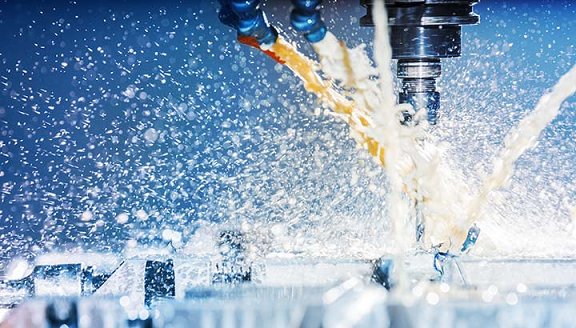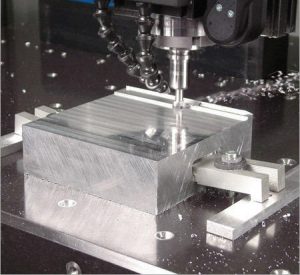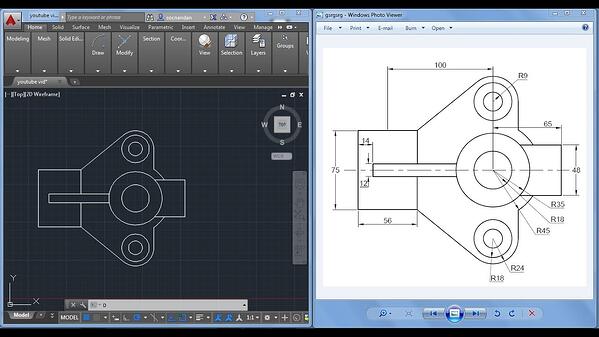Computer numerical control (CNC) machining has become more and more common in manufacturing. CNC technology provides a universal automated means to produce high-quality parts. The high precision and repeatability provided by the CNC machining process make it an ideal tool for most manufacturers. As they are becoming more and more popular, nowadays, it is easy to find several processing workshops that specialize in different CNC machining services.
This article focuses on some basic knowledge about CNC machining services, advantages and applications.
What Is CNC Machining?
 CNC machining is a term commonly used in manufacturing and industrial applications, but what exactly does the abbreviation of CNC stand for?
CNC machining is a term commonly used in manufacturing and industrial applications, but what exactly does the abbreviation of CNC stand for?
The term CNC stands for “computer numerical control”, and CNC machining is defined as a subtractive manufacturing process, usually using computer control and machine tools to remove the material layer from the workpiece and produce custom-designed parts. Different processing modes, inserts and shafts can be used in turning, milling and other processes to obtain the best results. This process is suitable for various materials, including metal, plastic, wood, glass, foam and composite materials, and is used in various industries, such as large-scale CNC machining and CNC machining of aerospace parts.
The automated nature of CNC machining enables the production of high precision and high accuracy, simple parts and the cost-effectiveness when fulfilling one-off and medium-volume production runs. CNC machining uses computer control to handle the entire machining process from start to finish, and finally production Produce consistent precision parts. CNC machining is particularly advantageous due to its automation capabilities. Automation enables the machine to run on its own, thereby reducing manual labor and producing accurate parts.
Process Overview of CNC Machining
All CNC machining operations start from the CAD model of the part. The CAM program reads the generated file and converts it into a series of coding instructions that the processing equipment can follow. The main benefit of using these processes is that once the document is approved, there is almost no human intervention (if any). Instead, computerized controls monitor and guide the movement of the machine, thereby minimizing potential errors and obtaining extremely consistent results.
Different CNC machining equipment can handle different tools, functions and operations. The CNC machining process usually includes the following steps:
1. Design CAD model
The CNC machining process starts in-house or is created by a CAD/CAM design service company to create a 2D vector or 3D solid part CAD design. Computer-aided design (CAD) software enables designers and manufacturers to generate models or renderings of their parts and products, including detailed information such as the geometry, dimensions and other technical specifications of the parts.
After finishing the CAD design, the designer exports it to a CNC compatible file format, such as STEP or IGES.
2. Convert CAD files to CNC programs
After the design is completed, convert the design specification into a direction that the CNC machine can follow. CAD files are run through computer-aided manufacturing (CAM) software. These programs will create programming codes, which the CNC machine will use to orient the tool during machining. The software also extracts information about the geometry of the part, which the operator can use to ensure that the initial part has the correct size and orientation.
These CNC-compatible instruction sets are usually one of the following two file types: STEP or IGES. They include G code and M code. The most famous general-purpose or geometric codes in the CNC programming language (called G codes) control when, where, and how the machine tool moves (for example, when it is turned on or off, and how fast it moves to the machine tool). The specific location on the workpiece, what path to take, etc. Miscellaneous function codes (called M codes) control auxiliary functions of the machine, such as automatic removal and replacement of machine covers at the beginning and end of production.
After generating the CNC program, the operator loads it onto the CNC machine tool.
3. Prepare CNC machine tools
Compared with automated manufacturing, manual operations play a much smaller role in automated manufacturing, but they still handle important operations that machinery cannot manage.
Including loading the CNC program file into the machine tool, fixing the workpiece directly on the machine, on the mechanical spindle, or on the vise or similar workpiece fixing device, and connect the required tools (such as drill bits and end mills) to the appropriate machine components to check the work area, machine and workpiece.
4. Perform processing operations
After preparing the equipment and starting the program, it submits the machine commands indicating the tool action and movement to the integrated computer of the machine. The computer operates and manipulates the machine tool, and the CNC machining equipment will execute the steps and perform processing operations on the workpiece. The program guides the machine through the entire process while performing the necessary machine operations to produce custom-designed parts or products without further operator input. After completing the instructions, the parts can continue the finishing and packaging process.
Types of CNC Machining Operations
The following are some commonly used processing techniques. Each of these processes plays a key role in manufacturing the part and enhancing its unique performance.
CNC Turning
During turning, the workpiece is rotated, and the cutting tool is placed on a moving slider and fed into the workpiece to remove the material of the desired pattern. The slider can rotate the length of the workpiece up and down.
Likewise, it can move away from or close to the centerline. This operation is very suitable for quickly removing large amounts of material.
Lathes are commonly used turning equipment for making concentric shapes on the outer circumference of circular parts. The lathe can make grooves, annular grooves, stepped shoulders, internal and external threads, cylinders and shafts-many round or round features. They can also produce a characteristic smooth and uniform surface finish.
CNC Milling
The fundamental difference between milling and turning is that the workpiece remains stationary and the cutting tool rotates on the spindle. Generally, the workpiece is fixed horizontally in a vise, which is installed on a worktable that moves in the X and Y directions. The main shaft is equipped with various cutting tools and can move on the X, Y and Z axes.
(More about CNC milling at What is CNC Milling? )
Milling includes two ways: peripheral milling and face milling. Peripheral milling can cut deep grooves, and face milling can cut the plane of the workpiece. Milling can be used as an auxiliary process for processed workpieces. Milling cutters are used to make squares/flats, notches, chamfers, grooves, contours, keyways and other features that depend on the precise cutting angle.
Although the rolling mill can also drill, it is good at removing blanks from more complex and asymmetrical parts.
As with all metal processing operations, use cutting fluid to cool the workpiece and cutting tools, lubricate and wash away metal particles.
Like turning centers, milling machines that can perform a series of operations on parts without operator intervention are common, often referred to as vertical or horizontal machining centers. They are always based on CNC. Milling and turning are jointly responsible for most CNC machine operations.
Surface Grinding
Many applications require very flat surfaces of metal parts. The best way to make this precise surface is to use a grinder. The surface grinder reciprocates on the worktable while feeding the workpiece into the grinding wheel. The depth of the wheel cut is usually between 0.00025 and 0.001 inches. The cylindrical grinder fixes the workpiece in the center and rotates, while applying the outer periphery of the rotating grinding wheel to it.
Centerless grinding is used for mass production of small parts whose ground is not related to any other surface except the whole.
Grinding is used to remove small amounts of material from flat and cylindrical shapes. Depending on the material to be ground, different types of abrasives are used. The heat and mechanical stress during the grinding process can adversely affect the workpiece, so the speed and temperature of the tool must be carefully controlled.
EDM
Electrical discharge machining, also called spark erosion, uses electrical discharge to make the required cuts on the workpiece. EDM can be used with workpieces made of conductive materials. This uses sparks transmitted from the electrode to the surface of the conductive workpiece through the dielectric fluid. By this method, very fine features can be processed, including small diameter holes, mold cavities, etc., without the need for heat treatment to soften them.
Advantages of CNC Machining
Compared with traditional manufacturing methods, CNC machining has many advantages. Many manufacturers prefer CNC machining technology. The advantages of CNC machining are as follows:
Greater Precision and Accuracy
The CNC machine can replicate the same parts thousands of times, and each part has the same size as the previous part. In addition, CNC machining uses very detailed programming operations compared to manual machining methods. The machine follows these instructions and does not allow any unnecessary changes or human errors. The parts will be high quality, precise and identical. CNC machining can also produce parts with complex designs.
Increased Productivity
The CNC machining process also saves a lot of time and improves production efficiency. For traditional machining equipment, the operator must manually configure and set the machine for each operation. On the contrary, CNC machining equipment can make necessary changes by simply adjusting the computer code. Equipment with CNC machining can produce 24/7 parts. The machine can run continuously with little manual intervention.
Broader Versatility
CNC machining operations are suitable for multiple designs of metals, polymers and other materials. The availability of vertical and horizontal CNC milling machines and multi-axis CNC milling centers provides excellent versatility. They can accurately handle projects with various complexity and parameters. This versatility makes it suitable for manufacturing many different parts and products
High Consistency
Once the master file of the design has been created, you can use it to create an unlimited number of copies, all copies are of the same quality, without any deviation, and each part will perfectly match the previous version.

Industries&Application of CNC Machining
CNC machining has been applied in many industries. It is an ideal choice especially for industries that require highly accurate parts.
In the medical industry:
Produce a large number of standard precision parts and customized equipment for patient treatment. The medical industry relies on customized products to meet the many needs of its patients. Parts in this industry require high precision to ensure that each component has the exact dimensions required. The parts that can be assembled together must have the smallest margin of error to avoid medical misdiagnosis and part failure.
In the aerospace industry:
Manufacture precise and tight tolerance components with complex and intricate designs for aircraft. CNC machining in the aerospace industry must meet these high-precision requirements. By using CNC machining to create parts, the aerospace industry has obtained the required customized parts with extremely high tolerance requirements.
In the transportation industry:
Because CNC machines can use a variety of materials to make parts, everything from brakes to engine parts and even tools are products that these machines can make. The transportation industry may require CNC machine-made parts including parts used in its various vehicles, parts for testing and prototyping more advanced equipment and systems.
In the electronics industry:
Although machining can produce large parts, it is also excellent at designing small parts (such as those used in the electronics industry). The smaller the part, the tighter the tolerance. When it comes to electronic and electrical components, there is little room for error in the micromachining process. Handing over the tasks of cutting and control tools to a computer can increase the possible accuracy to a level that humans cannot achieve. The electronics industry has greatly benefited from the excellent accuracy of CNC machined parts.
In the oil and gas industry:
In order to manufacture large machines for oil refineries and drilling rigs, the petrochemical industry needs precision parts that are well assembled together. CNC operations can produce large or small parts for the industry, as well as the components required for the electronic gears that are increasingly used in the industry.
Contact With SANS Machining Expert
CNC machining is ideal for producing parts and products for virtually every industry. It offers greater precision, accuracy, and processing speeds.
At SANS Machining, we understand the need for quality, consistency, and responsive customer service.
As a machining manufacturing factory, we have more then 10 years experience who specialize in producing custom CNC machined parts with No MOQ, Fast Delivery and Quality Products.
For additional information about our CNC machining capabilities or other fastener products and services, request a quote today.




